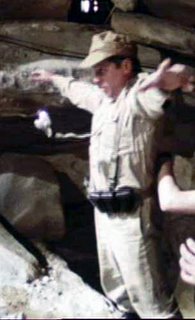DOSSIER ESPECIAL NAZIS: STUNTS




(A WAY TO RE-ENCATING)
A stunt is an unusual and difficult physical feat, or any act requiring a special skill, performed for artistic purposes in theatre or cinema. Stunts are a big part of many action movies. Before computer generated imagery special effects, there was no way of achieving these effects, except by using stunt performers who really would jump from car to car or hang from the edge of a skyscraper.
Stage Combat is the practice of creating the illusion of physical combat for plays, theater, or film. When a story or script calls for one character to act violently on another, stage combat is employed. The primary process of stage combat to create a visual and auditory picture which looks like real fighting, but in which none of the actors are harmed. This is done primarily by taking advantage of audience distance and fixed point of view, and by the actor's "faking" of appropriate strikes and responses.
Stage combat can include simple slaps and punches, basic hand to hand fighting, and advanced crafts such as swordplay, fighting with various weapons, and martial arts.
For example, if a script calls for one character to punch another in the face, the actor will place himself face to face with his partner, and then "throw" a punch which does not actually contact with the person he is "hitting." (the fist passes by the head, on the opposite side of the intended audience) At the same moment, the partner will jerk his head back as though he has been punched. Either one may also slap his hand against a soft part of their own body, creating a slapping noise, or knap. If the timing is correct, the illusion is very convincing, even for people watching at a very close distance.
There are literally dozens of variations just on a simple punch, and actors or choreographers choose the best one based on the story, the desired effect, and the placement of the audience.
In addition to using "fake" strikes, stage combat also often includes striking against a soft part of the body or striking very lightly, again counting on the response of the blow's recipient to "sell" that they have been hurt.
Advanced stage combat such as swordplay is mostly dependent upon careful choreography and extensive practice between the combatants. Scenes are choreographed and practiced at very slow speeds, and then slowly brought up to full speed as the actors become more secure. Actors develop cues within their combat to make sure their timing is the same. The combat phase of a play rehearsal is referred to as a fight call.
The primary concern of fight choreographers and stage combatants is ensuring the safety of the performers and audience. Even stage combat is risky, and it is perferable for actors to have as much training and experience as possible. Most professional actor training programs include studies in stage combat. A show which includes a great deal of fighting will most likely have a fight choreographer and a fight captain, who runs fight calls and ensures that actors are remaining safe.
Practical effects
One of the most-frequently used practical stunts is stage combat. Rather than actually striking an opponent, the actors stand a little farther away from each other. With learned skills and the careful placement of actors and the audience (in theatre) or the movie cameras (in film), one can hardly tell that the actors are not actually hitting one another.
Examples
Tripping and falling down
Fake fighting
Fake blood
High jump


<< Home